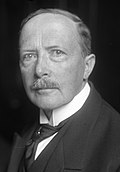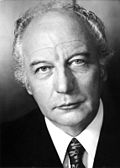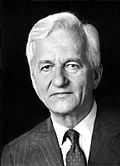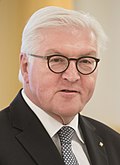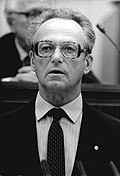History
Germany was ruled by monarchs from the beginning of division of the Frankish Empire in August 843 to the dissolution of the Holy Roman Empire in August 1806. [1] [2] [3] During most of 19th century, independent German principalities were organized into various confederations, such as the Confederation of the Rhine dominated by Napoleon (1806-1813) and the German Confederation created by the Congress of Vienna (1814-1866). The Prussian-led North German Confederation (1866-1871) subsequently morphed into a modern nation state, the German Reich, which was ruled by emperors from 1871 to the collapse of all German monarchies in 1918.
Contents
- History
- East Frankish kingdom, 843–962
- Holy Roman Empire, 962–1806
- Confederation of the Rhine, 1806–1813
- German Confederation, 1815–1866
- North German Confederation, 1867–1871
- German Reich, 1871–1945
- Federal Republic of Germany, from 1949
- German Democratic Republic (East Germany), 1949–1990
- Styles
- Notes
- References
The President of Germany replaced the monarch in 1919. Chancellor Adolf Hitler assumed the duties of head of state as Führer and Chancellor from 1934 until his suicide in April 1945. In 1949, Germany was divided into two states. The Federal President, head of state of West Germany, became head of state for all of Germany following German reunification in 1990.
East Frankish kingdom, 843–962
Carolingians
| Seal/Portrait | Name | House | King | Emperor | Ended | Notes |
|---|---|---|---|---|---|---|
 | Louis the German Ludwig der Deutsche | Carolingian | 11 August 843 | — | 23 August 876 | Son of Emperor Louis the Pious and grandson of Charlemagne |
 | Carloman (Karlmann) | Carolingian | 28 August 876 | — | 22 March 880 | Son of Louis the German; ruled in Bavaria; from 877, also King of Italy |
 | Louis the Younger (Ludwig III. der Jüngere) | Carolingian | 28 August 876 | — | 20 January 882 | Son of Louis the German; ruled in East Francia, Saxony; from 880, also Bavaria |
 | Charles the Fat (Karl III. der Dicke) | Carolingian | 28 August 876 | 12 February 881 | 11 November 887 | Son of Louis the German; ruled in Alemannia, Raetia, from 882 in the entire Eastern Kingdom; from 879, also King of Italy |
 | Arnulf of Carinthia (Arnulf von Kärnten) | Carolingian | 30 November 887 | 25 April 896 | 8 December 899 | Illegitimate son of Carloman |
 | Louis the Child (Ludwig IV. das Kind) | Carolingian | 21 January 900 | — | 20/24 September 911 | Son of Arnulf of Carinthia |
Conradine dynasty
| Seal | Name | House | King | Emperor | Ended | Notes |
|---|---|---|---|---|---|---|
 | Conrad I (Konrad I.) | Conradine (Franconian) | 10 November 911 | — | 23 December 918 | Elected by the nobility |
Ottonian dynasty
| Seal | Name | House | King | Emperor | Ended | Notes |
|---|---|---|---|---|---|---|
 | Henry I the Fowler (Heinrich I. der Vogler) | Liudolfing (Saxon) | 23 April 919 | — | 2 July 936 | Elected by the nobility |
 | Arnulf the Bad (Arnulf der Böse, Herzog von Bayern) | Luitpolding (Bavarian) | 919 | — | 921 | Rival king to Henry I |
Holy Roman Empire, 962–1806
The title "King of the Romans", used under the Holy Roman Empire, is (from this point onwards) considered equivalent to King of Germany. A king was chosen by the German electors and would then proceed to Rome to be crowned emperor by the pope.
Ottonian dynasty (continued)
| Image | Name | House | King | Emperor | Ended | Notes |
|---|---|---|---|---|---|---|
 | Otto I the Great (Otto I. der Große) | Ottonian | 7 August 936 | 2 February 962 | 7 May 973 | Son of Henry I; first king crowned in Aachen Cathedral since Lothair I; crowned as Otto by the grace of God King; [4] crowned Holy Roman Emperor in 961 |
 | Otto II the Red (Otto II.) | Ottonian | 26 May 961 | 25 December 967 | 7 December 983 | Son of Otto I; Otto by the grace of God King [4] under his father 961–973; also crowned Emperor in his father's lifetime |
 | Otto III (Otto III.) | Ottonian | 25 December 983 | 21 May 996 | 21 January 1002 | Son of Otto II; Otto by the grace of God King [4] |
 | Henry II (Heinrich II. der Heilige) | Ottonian | 7 June 1002 | 26 April 1014 | 13 July 1024 | Great-grandson of Henry I |
Salian dynasty
| Image | Name | House | King | Emperor | Ended | Notes |
|---|---|---|---|---|---|---|
 | Conrad II (Konrad II.) | Salian (Frankish) | 8 September 1024 | 26 March 1027 | 4 June 1039 | Great-great-grandson of Otto I |
 | Henry III (Heinrich III.) | Salian | 14 April 1028 | 25 December 1046 | 5 October 1056 | Son of Conrad II; King (of the Germans?) [4] under his father 1028–1039 |
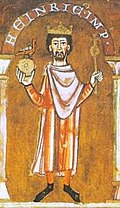 | Henry IV (Heinrich IV.) | Salian | 17 July 1054 | 21 March 1084 | 31 December 1105 | Son of Henry III; King of Germany under his father, 1054–1056 |
 | Rudolf of Rheinfelden (Rudolf von Rheinfelden) | Rheinfeld | 15 March 1077 | — | 15 October 1080 | Rival king to Henry IV |
 | Hermann of Salm (Hermann von Luxemburg, Graf von Salm) | Salm | 6 August 1081 | — | 28 September 1088 | Rival king to Henry IV |
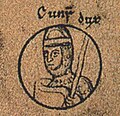 | Conrad (Konrad) | Salian | 30 May 1087 | — | 27 July 1101 | Son of Henry IV; King of Germany under his father, 1087–1098, King of Italy, 1093–1098, 1095–1101 in rebellion. |
 | Henry V (Heinrich V.) | Salian | 6 January 1099 | 13 April 1111 | 23 May 1125 | Son of Henry IV; King of Germany under his father, 1099–1105, forced his father to abdicate |
Supplinburger dynasty
| Image | Name | House | King | Emperor | Ended | Notes |
|---|---|---|---|---|---|---|
 | Lothair III (Lothar III.) | Supplinburger | 30 August 1125 | 4 June 1133 | 4 December 1137 | He was Lothair II of Germany, but Lothair III of Italy |
Hohenstaufen and Welf dynasties
| Image | Name | House | King | Emperor | Ended | Notes |
|---|---|---|---|---|---|---|
 | Conrad III (Konrad III.) | Hohenstaufen | 7 March 1138 | — | 15 February 1152 | Grandson of Henry IV (through his mother); Previously Rival King to Lothair III 1127–1135 |
| Henry Berengar (Heinrich (VI.)) | Hohenstaufen | 30 March 1147 | — | August? 1150 | Son of Conrad III; King of Germany under his father 1147–1150 | |
 | Frederick I Barbarossa (Friedrich I. Barbarossa) | Hohenstaufen | 4 March 1152 | 18 June 1155 | 10 June 1190 | Nephew of Conrad III |
 | Henry VI (Heinrich VI.) | Hohenstaufen | 15 August 1169 | 14 April 1191 | 28 September 1197 | Son of Frederick I; King of Germany under his father 1169–1190 |
 | Frederick II (Friedrich II.) | Hohenstaufen | 1197 | — | 1197 | Son of Henry VI; King of Germany under his father, 1196 |
 | Philip of Swabia (Philipp von Schwaben) | Hohenstaufen | 6 March 1198 | — | 21 August 1208 | Son of Frederick I; rival king to Otto IV |
 | Otto IV (Otto IV. von Braunschweig) | Welf | 29 March 1198 | 4 October 1209 | 5 July 1215 | Rival king to Philip of Swabia; later opposed by Frederick II; deposed, 1215; died 19 May 1218 |
 | Frederick II (Friedrich II.) | Hohenstaufen | 5 December 1212 | 22 November 1220 | 26 December 1250 | Son of Henry VI; Rival king to Otto IV until 5 July 1215 |
 | Henry (Heinrich (VII.)) | Hohenstaufen | 23 April 1220 | — | 15 August 1235 | Son of Frederick II; King of Germany under his father, 1220–1235 |
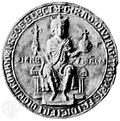 | Conrad IV (Konrad IV.) | Hohenstaufen | May 1237 | — | 1 May 1254 | Son of Frederick II; King of Germany under his father, 1237–1250 |
Interregnum
| Image | Coat of arms | Name | House | King | Emperor | Ended | Notes |
|---|---|---|---|---|---|---|---|
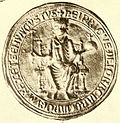 |  | Henry Raspe (Heinrich Raspe) | Thuringia | 22 May 1246 | — | 16 February 1247 | Rival King to Frederick II and great-great-great grandson of Henry IV |
 |  | William of Holland (Wilhelm von Holland) | Holland | 3 October 1247 | — | 28 January 1256 | Rival King to Frederick II and Conrad IV, 1247–1254 |
 |  | Richard of Cornwall (Richard von Cornwall) | Plantagenet | 13 January 1257 | — | 2 April 1272 | Brother-in-law of Frederick II; rival king to Alfonso of Castile; held no real authority. |
 |  | Alfonso of Castile (Alfons von Kastilien) | House of Ivrea | 1 April 1257 | — | 1275 | Grandson of Philip; rival king to Richard of Cornwall; held no authority; later opposed by Rudolf I; relinquished claims 1275, died 1284 |
Changing dynasties
| Image | Coat of arms | Name | House | King | Emperor | Ended | Notes |
|---|---|---|---|---|---|---|---|
 |  | Rudolf I (Rudolf I. von Habsburg) | Habsburg | 29 September 1273 | — | 15 July 1291 | First of the Habsburgs |
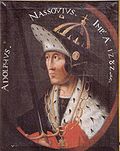 |  | Adolf of Nassau (Adolf von Nassau) | Nassau | 5 May 1292 | — | 23 June 1298 | According to some historians, Adolf's election was preceded by the short-lived kingship of Conrad, Duke of Teck. See his article for details. |
 |  | Albert I (Albrecht I. von Habsburg) | Habsburg | 24 June 1298 | — | 1 May 1308 | Son of Rudolf I; Rival king to Adolf of Nassau, 1298 |
 |  | Henry VII (Heinrich VII. von Luxemburg) | Luxembourg | 27 November 1308 | 13 June 1311 | 24 August 1313 | Holy Roman Emperor |
 |  | Louis IV (Ludwig IV. der Bayer) | Wittelsbach | 20 October 1314 | 17 January 1328 | 11 October 1347 | Grandson of Rudolf I; rival king to Frederick the Fair, 1314–1322 |
 |  | Frederick the Fair (Friedrich der Schöne) | Habsburg | 19 October 1314/ 5 September 1325 | — | 28 September 1322/ 13 January 1330 | Son of Albert I; rival king to Louis IV, 1314–1322; associate king with Louis IV, 1325–1330 |
 |  | Charles IV (Karl IV. von Luxemburg) | Luxembourg | 11 July 1346 | 5 April 1355 | 29 November 1378 | Grandson of Henry VII; rival king to Louis IV, 1346–1347; also King of Bohemia, King of Italy and Holy Roman Emperor |
 |  | Günther von Schwarzburg (Günther von Schwarzburg) | Schwarzburg | 30 January 1349 | — | 24 May 1349 | Rival king to Charles IV |
 |  | Wenceslaus (Wenzel von Böhmen) | Luxembourg | 10 June 1376 | — | 20 August 1400 | Son of Charles IV; king of Germany under his father 1376–1378; deposed 1400; also by inheritance King of Bohemia; died 1419 |
 |  | Rupert of the Palatinate (Ruprecht von der Pfalz) | Wittelsbach | 21 August 1400 | — | 18 May 1410 | Great-grandnephew of Louis IV |
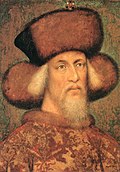 |  | Sigismund (Sigismund von Luxemburg) | Luxembourg | 20 September 1410 /21 July 1411 | 3 May 1433 | 9 December 1437 | Son of Charles IV |
 |  | Jobst of Moravia (Jobst von Mähren) | Luxembourg | 1 October 1410 | — | 8 January 1411 | Nephew of Charles IV; rival king to Sigismund |
Habsburg
| Image | Coat of arms | Name | House | King | Emperor | Ended | Notes |
|---|---|---|---|---|---|---|---|
 |  | Albert II (Albrecht II.) | Habsburg | 18 March 1438 | — | 27 October 1439 | 4th in descent from Albert I; son-in-law of Sigismund |
 |  | Frederick III (Friedrich III.) | Habsburg | 2 February 1440 | 16 March 1452 | 19 August 1493 | 4th in descent from Albert I; 2nd cousin of Albert II |
 |  | Maximilian I (Maximilian I.) | Habsburg | 16 February 1486 | 4 February 1508 | 12 January 1519 | Son of Frederick III; King of Germany under his father, 1486–1493; assumed the title "Elected Emperor" in 1508 with the pope's approval |
 |  | Charles V (Karl V.) | Habsburg | 28 June 1519 | 28 June 1519 | 3 August 1556 | Grandson of Maximilian I; died 21 September 1558 |
 |  | Ferdinand I (Ferdinand I.) | Habsburg | 5 January 1531 | 14 March 1558 | 25 July 1564 | Grandson of Maximilian I; brother of Charles V; King of Germany under his brother Charles V 1531–1556; last king to be crowned in Aachen Cathedral. Emperor |
 |  | Maximilian II (Maximilian II.) | Habsburg | 22 November 1562 | 25 July 1564 | 12 October 1576 | Son of Ferdinand I; King of Germany under his father 1562–1564 |
 |  | Rudolf II (Rudolf II.) | Habsburg | 27 October 1575 | 2 November 1576 | 20 January 1612 | Son of Maximilian II; King of Germany under his father, 1575–1576 |
 |  | Matthias (Matthias) | Habsburg | 13 June 1612 | 13 June 1612 | 20 March 1619 | Son of Maximilian II |
 |  | Ferdinand II (Ferdinand II.) | Habsburg | 28 August 1619 | 28 August 1619 | 15 February 1637 | Grandson of Ferdinand I |
 |  | Ferdinand III (Ferdinand III.) | Habsburg | 22 December 1636 | 15 February 1637 | 2 April 1657 | Son of Ferdinand II; King of Germany under his father 1636–1637 |
 |  | Ferdinand IV (Ferdinand IV.) | Habsburg | 31 May 1653 | — | 9 July 1654 | Son of Ferdinand III; King of Germany under his father |
 |  | Leopold I (Leopold I.) | Habsburg | 18 July 1658 | 18 July 1658 | 5 May 1705 | Son of Ferdinand III |
 |  | Joseph I (Joseph I.) | Habsburg | 23 January 1690 | 5 May 1705 | 17 April 1711 | Son of Leopold I; King of Germany under his father 1690–1705 |
 |  | Charles VI (Karl VI.) | Habsburg | 27 October 1711 | 27 October 1711 | 20 October 1740 | Son of Leopold I |
Wittelsbach
| Image | Coat of arms | Name | House | King | Emperor | Ended | Notes |
|---|---|---|---|---|---|---|---|
 |  | Charles VII (Karl VII.) | Wittelsbach | 14 January 1742 | 14 January 1742 | 20 January 1745 | Great-great-grandson of Ferdinand II; Husband of Maria Amalia, daughter of Joseph I |
Habsburg-Lorraine
| Image | Coat of arms | Name | House | King | Emperor | Ended | Notes |
|---|---|---|---|---|---|---|---|
 |  | Francis I (Franz I.) | Lorraine | 13 September 1745 | 13 September 1745 | 18 August 1765 | Great-grandson of Ferdinand III; Husband of Maria Theresa, daughter of Charles VI |
 |  | Joseph II (Joseph II.) | Habsburg-Lorraine | 27 March 1764 | 18 August 1765 | 20 February 1790 | Son of Francis I and Maria Theresa; King of Germany under his father 1764–1765 |
 |  | Leopold II (Leopold II.) | Habsburg-Lorraine | 30 September 1790 | 30 September 1790 | 1 March 1792 | Son of Francis I and Maria Theresa |
 |  | Francis II (Franz II.) | Habsburg-Lorraine | 7 July 1792 | 7 July 1792 | 6 August 1806 | Son of Leopold II; Dissolved the Holy Roman Empire; also Emperor of Austria 1804–1835; President of the German Confederation (1815-1835), died 1835 |
Confederation of the Rhine, 1806–1813
| Name | Portrait | Title | House | Began | Ended |
|---|---|---|---|---|---|
| Napoleon Emperor of the French King of Italy |  | Protector of the Confederation of the Rhine |  Bonaparte | 12 July 1806 | December 1813 |
| Karl Theodor von Dalberg, Prince-Archbishop of Regensburg Grand Duke of Frankfurt | 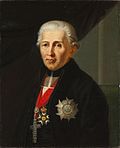 | Prince-primate of the Confederation of the Rhine |  Dalberg | 25 July 1806 | 26 October 1813 |
| Eugène de Beauharnais, Grand Duke of Frankfurt |  | Prince-primate of the Confederation of the Rhine |  Beauharnais | 26 October 1813 | December 1813 |
German Confederation, 1815–1866
| Name | Portrait | Title | House | Began | Ended |
|---|---|---|---|---|---|
| Francis I, Emperor of Austria (Franz I., Kaiser von Österreich) |  | Head of the presiding power (Präsidialmacht) Austria [5] |  Habsburg-Lorraine | 20 June 1815 | 2 March 1835 |
| Ferdinand I, Emperor of Austria (Ferdinand I., Kaiser von Österreich) | 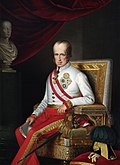 | Head of the presiding power (Präsidialmacht) Austria [5] |  Habsburg-Lorraine | 2 March 1835 | 12 July 1848 |
| Archduke John of Austria (Erzherzog Johann von Österreich) | 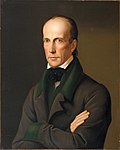 | Regent ( Reichsverweser ) of the revolutionary German Empire [6] |  Habsburg-Lorraine | 12 July 1848 | 20 December 1849 |
| Frederick William IV, King of Prussia (Friedrich Wilhelm IV., König von Preußen) | 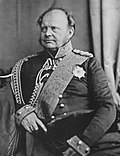 | Emperor of the Germans elect [7] | 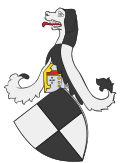 Hohenzollern | 28 March 1849 | 28 April 1849 |
| Presidium of the Union (Unionsvorstand) of the Erfurt Union [8] | 26 May 1849 | 29 November 1850 | |||
| Francis Joseph I, Emperor of Austria (Franz Joseph I., Kaiser von Österreich) |  | Head of the presiding power (Präsidialmacht) Austria |  Habsburg-Lorraine | 1 May 1850 | 24 August 1866 |
North German Confederation, 1867–1871
| Name | Portrait | Title | House | Began | Ended |
|---|---|---|---|---|---|
| Wilhelm I, King of Prussia (Wilhelm I, König von Preußen) |  | Holder of the Bundespräsidium of the North German Confederation |  Hohenzollern | 1 July 1867 | 1 January 1871 [9] |
German Reich, 1871–1945
German Emperor, 1871-1918
| Name | Portrait | Title | House | Began | Ended |
|---|---|---|---|---|---|
| Wilhelm I, German Emperor (Wilhelm I., Deutscher Kaiser) |  | German Emperor |  Hohenzollern | 1 January 1871 [9] | 9 March 1888 |
| Friedrich III, German Emperor (Friedrich III., Deutscher Kaiser) |  | German Emperor |  Hohenzollern | 9 March 1888 | 15 June 1888 |
| Wilhelm II, German Emperor (Wilhelm II., Deutscher Kaiser) |  | German Emperor |  Hohenzollern | 15 June 1888 | 9/28 November 1918 [10] |
President, 1919–1945
† denotes people who died in office.
| Portrait | Reichspräsident | Took office | Left office | Time in office | Party | Election | |
|---|---|---|---|---|---|---|---|
| Friedrich Ebert (1871–1925) | 11 February 1919 | 28 February 1925 † | 6 years, 17 days | SPD | 1919 | ||
| Hans Luther (1879–1962) Acting [a] | 28 February 1925 | 12 March 1925 | 12 days | Nonpartisan | – | ||
| Walter Simons (1861–1937) Acting [b] | 12 March 1925 | 12 May 1925 | 61 days | Nonpartisan | – | ||
| Generalfeldmarschall Paul von Hindenburg (1847–1934) | 12 May 1925 | 2 August 1934 † | 9 years, 82 days | Nonpartisan | 1925 1932 | ||
| Adolf Hitler (1889–1945) Führer und Reichskanzler | 2 August 1934 | 30 April 1945 † | 10 years, 271 days | NSDAP | – | ||
| Großadmiral Karl Dönitz (1891–1980) | 30 April 1945 | 23 May 1945 | 23 days | NSDAP | – | ||
Federal Republic of Germany, from 1949
† denotes people who died in office.
| Portrait | Bundespräsident | Took office | Left office | Time in office | Party | Election | |
|---|---|---|---|---|---|---|---|
| Theodor Heuss (1884–1963) | 13 September 1949 | 12 September 1959 | 9 years, 364 days | FDP | 1949 1954 | ||
| Heinrich Lübke (1894–1972) | 13 September 1959 | 30 June 1969 (resigned) | 9 years, 290 days | CDU | 1959 1964 | ||
| Gustav Heinemann (1899–1976) | 1 July 1969 | 30 June 1974 | 4 years, 364 days | SPD | 1969 | ||
| Walter Scheel (1919–2016) | 1 July 1974 | 30 June 1979 | 4 years, 364 days | FDP | 1974 | ||
| Karl Carstens (1914–1992) | 1 July 1979 | 30 June 1984 | 4 years, 365 days | CDU | 1979 | ||
| Richard von Weizsäcker (1920–2015) | 1 July 1984 | 30 June 1994 | 9 years, 364 days | CDU | 1984 1989 | ||
| Roman Herzog (1934–2017) | 1 July 1994 | 30 June 1999 | 4 years, 364 days | CDU | 1994 | ||
| Johannes Rau (1931–2006) | 1 July 1999 | 30 June 2004 | 4 years, 365 days | SPD | 1999 | ||
| Horst Köhler (born 1943) | 1 July 2004 | 31 May 2010 (resigned) | 5 years, 334 days | CDU | 2004 2009 | ||
| Jens Böhrnsen (born 1949) Acting [c] | 31 May 2010 | 30 June 2010 | 30 days | SPD | – | ||
| Christian Wulff (born 1959) | 30 June 2010 | 17 February 2012 (resigned) | 1 year, 232 days | CDU | 2010 | ||
| Horst Seehofer (born 1949) Acting [c] | 17 February 2012 | 18 March 2012 | 30 days | CSU | – | ||
| Joachim Gauck (born 1940) | 18 March 2012 | 18 March 2017 | 5 years, 0 days | Independent | 2012 | ||
| Frank-Walter Steinmeier (born 1956) | 18 March 2017 | Incumbent | 8 years, 158 days | SPD | 2017 2022 | ||
German Democratic Republic (East Germany), 1949–1990
† denotes people who died in office.
| Portrait | Name | Took office | Left office | Time in office | Party | |
|---|---|---|---|---|---|---|
| President of the Republic Präsident der Republik | ||||||
| Wilhelm Pieck (1876–1960) | 11 October 1949 | 7 September 1960 † | 10 years, 332 days | SED | ||
| Johannes Dieckmann (1893–1969) Acting [d] | 7 September 1960 | 12 September 1960 | 5 days | LDPD | ||
| Chairman of the State Council Vorsitzender des Staatsrats | ||||||
| Walter Ulbricht (1893–1973) | 12 September 1960 | 1 August 1973 † | 12 years, 323 days | SED | ||
| Friedrich Ebert Jr. (1894–1979) Acting [e] | 1 August 1973 | 3 October 1973 | 63 days | SED | ||
| Willi Stoph (1914–1999) | 3 October 1973 | 29 October 1976 | 3 years, 26 days | SED | ||
| Erich Honecker (1912–1994) | 29 October 1976 | 18 October 1989 (resigned) | 12 years, 354 days | SED | ||
| Egon Krenz (born 1937) | 18 October 1989 | 6 December 1989 (resigned) | 49 days | SED | ||
| Manfred Gerlach (1928–2011) | 6 December 1989 | 5 April 1990 (office abolished) | 120 days | LDPD | ||
| President of the People's Chamber Präsident der Volkskammer | ||||||
| Sabine Bergmann-Pohl (born 1946) | 5 April 1990 | 2 October 1990 ( East Germany joined Federal Republic ) | 180 days | CDU | ||


